|
|
SERGUEY
SIPAROV (SAINT PETERSBURG)
 |
RUSSIAN
VACATIONS
(Trilogy)
(www.so-znanie.nm.ru)
|
In
this essay I am going to present the three stories of mountaineering
- the way it could take sometimes in Russia. First of them is about
the 1989 climb on the Korjenevskaya peak, Pamirs, second is about
the 1998 climb on the McKinley mountain (or as it is called now,
Denali peak), Alaska, the third is about the 2002 ascent on the
Kilimanjaro mountain, Africa. All of them were performed not by
professional climbers, but by those who just like mountains and
have some experience in tramping. The first two were done by the
team of four: Igor Gornushkin, Sergey Buldyrev, Michail Babich and
myself, who knew each other for years. In the last one I accompanied
the expedition consisting of Victor Boyarsky, the famous traveler
who crossed Greenland and Antarctica on feet as a member of the
international expeditions, the Director of Arctic Museum and polar
guide, Michail Bobrov, the honorary citizen of St-Petersburg, former
war hero and sportsman, Alexander Brinken, the Secretary of Russian
Geographic Society, Victor Serov, the traveler and polar guide and
Konstantin Antonenko, the businessman.
1.
Korjeneva.
In
the year 1988 I worked in the International Mountaineering Camp
on Pamirs as a kitchen-boy. I had had a lot of experience in tramps
in such mountain regions as Caucasus, Pamirs, Altay, but that year
I was absolutely out of money and decided to spend the summer in
a good place and earn something at the same time. The camp was on
the Fortambek glacier, on the Suloev glade, about 3000m above the
sea level. The surrounding scenery was great: Piter the First ridge
in front and the Communism Peak (7495m) to the left with that famous
Ski-jump glacier delivering jumping avalanches every other day.
Opposite the ridge the Korjenevskaya peak (7105m) was seen - a mighty
slanting pyramid of geometrical beauty, it had an 800m wall facing
our camp. In the end of the season it was clear that I had nothing
to do but to come back and climb this Korjeneva, preferably next
summer. By the way, there was some romance behind: Korjenevsky was
a geographer and traveler in the end of the 19-th or in the beginning
of the 20-th century, and his wife Eugenia Korjenevskaya accompanied
him in his expeditions. He took the survey map of the part of the
Pamirs and named the highest peaks of the region. He gave his own
name to the 6900m peak next to the highest peak he saw which he
named after his wife.
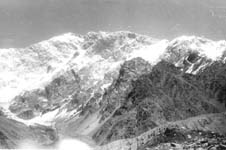
When I came back to Leningrad I told my friends:"Do as you
wish, but next year I am going to Korjeneva". I was not sure
of their plans and, besides, none of us had ever been higher than
5500m. But, of course, they all wished to go there too. Moreover,
Sergey Buldyrev was going to emigrate to the US and was looking
for a place to visit as a final bang. The wall was a bit too much
for us, but the classical ridge rout (category 5B with the extra
category due to the altitude) was OK. To all these routs we knew
that those who climbed there first had almost nothing but tough
guts and some health. And these we possessed.
In December 1988 I went to Dushanbe on a business trip and made
some preliminary steps to organize the helicopter which would take
us to Suloev glade in summer - that is made friends and drank vodka
with a pilot. In July 1989 we were there. The plan was the following.
We were going to make two acclimatization routs: to spend a night
on the White Stone peak (5000m) right above the glade (there is
a huge white stone on the summit with a vertical gap in it through
which one can have a view like through an embrasure) and then do
the same on the Pamirs Firn table (6200m) leading to the Communism
peak (14 long kilometers). And then to Korjeneva.
The ascent on the White Stone which I had visited twice last year
with no problem, this time appeared to be sheering hell for me.
I was moving like a sleep-walker and had to give direct and severe
orders to my body to perform every step. When I finally managed
to get to the top, the tent was already ready and the stove was
heating snow for the meal. No appetite, I made myself drink some
tea and eat a biscuit. Then crawled into the tent. Soon all the
guys were there too, and we tossed and turned preparing to sleep.
Suddenly, I brushed against my nose, and it started bleeding hard.
It bled and bled and I had to get out of the tent to put some snow
on it. I guess, I lost about a glass of blood until it stopped.
At that moment I noticed that all the weakness had gone and I felt
myself well as usually. It seems, all this was a high altitude effect
when the blood changes its viscosity and produces problems for the
heart. This caused the weakness. But now there was less blood to
pump through, and the heart coped with it. The night was fine, and
then we dropped down to spend a rest day on the glade.
That summer the weather was awful. Just to mention that out of 110
foreign climbers who were in the Fortambek International Mountaineering
Camp that year, 90 didn't managed to ascend. During the rest day
it was snowing hard, and in the evening we made a snow woman. Sculpturing
all the gender details, we giggled enjoying ourselves at rest. This
angered the Gods, and the storm in the following night nearly teared
our tent to shreds. Since then I renounced such sculpture affairs.
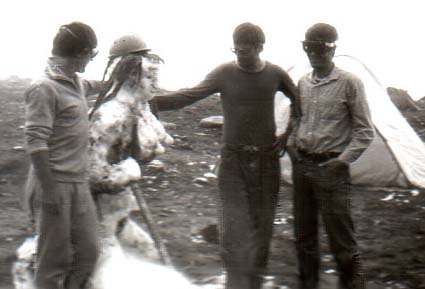
The next day we started to the Burevestnik ridge to get to the Firn
table. The ascent was not difficult but tiresome. When we were just
under the Verbliud (Camel) lodgings the weather proved itself again.
The wind and snow made us stop and put the tent on the small and
narrow ridge - the only place to put a tent on. Part of the tent
was drooping down the precipice but the tent was still a good home
and we spent a good night. The next day was no good at all. The
wind was roaring, the snow was continuously on and we could not
proceed. Several climbers who spent the night in the Verbliud camp
passed us going down and we waved good-bye to them. The next day
was a bit better, but only a bit. When we set out in the morning
and reached the Verbliud camp, all the rest of the climbers who
were there at that time were preparing to descend. When we said
that we were going up they looked at us as at crazies. No wonder.
All of them were equipped like all those guys in the sport magazines,
while we were in self-made clothes and had the old fashioned gear.
Yes, we knew how to use all those crampons, ice-axes and ropes,
but it was hard to believe it looking at us. The only team also
going up consisted of Vladimir Balyberdin and his companion who
were the guides of two Korean climbers. That inspired us and we
started to climb changing places with Balyberdin's team from time
to time. In several hours we were on the table, put the tent and
made a tea earlier than Balyberdin and his Korean (two others went
down half the way to the Firn table). It was an honor to invite
Bal to our tent to have some tea. Five-o-clock in the mountains.
The Korjenevskaya peak was in several kilometers just in front and
we observed it with hope. Three kilometers down the Suloev glade
with tiny spots of tents was seen in the mist. The next day we descended
to the glade and the second stage was over.
To get to the Korjeneva foot one has to go a long way down the Fortambek
glacier and cross it. After the days rest we did so and found ourselves
in a picturesque place on the moraine near the small creek coming
from under the ice. Some green plants were also seen and this was
like a warm farewell. Next day the ascent began. That day was unusually
hot and it was rather hard to go. We managed to get to the 5200m
camp and spent a night there. Surprisingly, there was a problem
with water although the camp was on the snow. This place is very
suitable for lodging, and since there usually are many groups spending
night there, the ecology of the place is very, very poor. In the
morning we continued the climb. In the beginning it was a steep
part with deep snow on it, and we had to move forward in the snow
to the waist. In the end it was another famous camp point - a horizontal
gap in the rock - where several groups stayed. Nobody dared to go
because of the misty weather promising wind and snow again. At first
we had some doubts about what to do, really, the avalanche situation
was dangerous, but finally we decided to proceed. On the ascent
we traversed a couple of crevices ready to drop the avalanches,
and I silently prayed. In the end of the rise (at 6200m) there was
a small bulkhead with place enough for a tent to stay. It was not
late but we decided to stop there and to get up early next morning
for the final burst. In the evening that day we were visited by
the head of the sport staff of the Moskvina International Mountaineering
Camp, who was leading his group from the summit which they had reached
that day. We gave him some tea and he stood a treat of four apples.
Tasty they were in that freezing and rarified air.
We started at 6 a.m. It was still dark and misty. At first there
was a couple of steep steps not easy to overcome, but then the slope
became more slant and we moved along breathing hard. We had to do
so for 8 kilometers horizontally and gain a vertical kilometer more.
On the route there were several dangerous places falling from which
led to the wall we saw from the glade, but we managed to pass them
safely. The main thing was to make oneself go, since every step
needed four inhales and four exhales and the consciousness was as
misty as the surroundings. On the halfway Misha said that he could
not go further, and we decided that he would return to our camp
on the bulkhead. Two hours later the thunderstorm began. The air
was full of electricity, the small lightnings stroke the ridge we
were ascending. I felt the electric stroke along my body twice and
Igor whose windbreaker was synthetic had it more. Serega was 40
or 50 meters ahead of us, but still we all moved too slowly. It
was already 4 p.m., we saw the summit, we were at 7000m because
the Korjenevskiy peak (6900m) was already below, but there was not
less than an hour to reach the top. Suddenly, Igor sat down and
said there was a sharp pain in his stomach. We had to return. What
a problem it was to shout to get Serega hear us. At last he turned
back and returned to us. "Igor, can you move?". "Not
fast". We went down. Two hundred meters lower the pain stepped
back. Soon we were at our tent totally exhausted. Misha had made
some tea and compote. It was such a relief. Though such a defeat.
I went aside to piss and saw a red spurt leaking out of me. Dehydration?
The night was really cold. We pressed to each other in our common
sleeping bag. At 3 a.m. I scrambled out of the tent. Jesus! The
weather was good! I saw the Communism peak on the opposite side
of the valley and the other mountains around. The frost was biting
but this promised some hope for the weather next day. Suddenly,
I felt absolutely sure that next day we would ascend. I crawled
back and wakened Igor. "The weather is fine, we will do it".
We started at 6 again.
This time the rout was not new, and all the four of us moved faster.
The weather was not so fine as we hoped, but still it was better
than yesterday. At 4 p.m. we were on the top. Taking shots we laughed:
no way to prove you are on the Korjeneva summit, only white mist
around. Still, we were there. The descent was dangerous. Feeling
that everything is already behind, we went quickly, paying little
attention to the dangerous places with 800m fall. In one of them
my foot slipped, I fell head forward and hardly managed to stop
with the help of the ice-axe. Third night on the bulkhead was a
celebration.
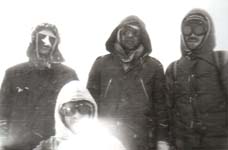
In the morning the sun was shining. We went down, again through
these awful crevices full of ready to go avalanches, again I prayed
crossing them, again we passed the Gap, again this friable deep
snow, down, down, down. On the way we met the climbers who were
in a hurry to use the weather to go up. Oh, how hard they breathed!
Poor devils. How lightly we breathed gulping that air that became
thicker with every step down. In the evening we were on the same
moraine with the green grass. Unbelievable. Sipping warm air, eating
hot soup, drinking cold compote. We talked of future, and Serega,
who was going to the US, said: "See you on McKinley!".
We laughed heartily. Good joke. It was time then, when even to think
of going abroad was impossible, to say nothing of some Alaska, known
only from Jack London's books.
We returned to the Suloev glade and began waiting for the helicopter
to come. Mind, that we didn't pay for it. My pilot friend took us
here together with some group who ordered the chopper. When will
he come now? Not far from us there was Balyberdin's team. They didn't
manage to ascend - Korea is not a climbing country. They were also
waiting for the chopper, which THEY payed for. In a day or two it
came. Its propeller was still rotating when a guy jumped out of
it and ran in our direction. Bal and his Koreans took their stuff
and intended to move towards the chopper. We stood timidly aside.
"Where is Siparov and three with him?" cried the guy.
"Here we are!" cried we overjoyed. Bal was astonished.
What the hell?! This is THEIR chopper by all means. Who argues?
There appeared to be room enough for both teams, and the pilot is
the boss there. Bal, being a Soviet, smiled, Koreans didn't understand
anything, we took our seats. On the way back we flew in parallel
to the small AN-2 plane heading to Dushanbe. Having boarded the
jet to Leningrad, we flew near the Pamirs. Everything was in the
clouds again. Only the Korjeneva peak, the pyramid of which we knew
so well, and the Communism peak sticked out beside each other.
2.
McKinley
The
time went on, Serega went to America, found a job in the University,
his position became solid. Writing letters to each other, we still
ended them with "See you on MacKinley", but for years
it remained a joke. In 1993 Igor went to America too. Since it was
not him who pronounced this joke, he for some time was out of this
play. But in several years it suddenly turned out that we could
take it seriously. I started saving money. Serega learned all the
details. The preliminary plan was for 1997, but that time there
appeared some job problems and we postponed it for a year. Those
Americans are tough guys and make money out of everything. You can't
get to McKinley without being approved by the rangers and without
buying a permit. To say nothing of the plane to the glacier. No
haliava at all. Still, all this is a small amount in comparison
to the air tickets. But. Igor and Serega lived in the US, Misha
worked abroad from time to time and earned something there. And
my job permited me (demanded!) to visit some distant places in Russia.
Like Magadan. Which is much closer to Alaska, than St-Petersburg.
Therefore, I can fly to Magadan and back for free, and only Magadan-Anchorage
flight is left. Thus, the money problem is solvable.
We met in Anchorage in June, 1998. Misha flew from St-Petersburg
to New York and then to Boston, where Serega lives. Then they flew
to Anchorage together. Igor flew from Florida. I went in the opposite
direction to Magadan and met them all in Anchorage. Four ants on
the globe. Here we are.
We had to spend the night in the Anchorage International airport.
Seats aside, common sleeping bag out on the floor, nobody mentions.
Good people. In the morning the car came and took us to Talkeetna
- a small village where the expeditions start. A visit to rangers.
The rout up the Kaheeltna glacier full of crevasses on the large
TV screen. Civilization. Lots of stuff, mostly food, to be packed
and transported to the Kaheeltna camp (2200m) by plane. We expect
20 days to fulfill the expedition. The average time it takes to
climb McKinley (6200m) and descent to Kaheeltna camp is two weeks,
but we are planning to return to Talkeetna by feet and have a look
at Alaskan tundra.
There are two main problems with McKinley. First is crevasses, that
is why the ascent can be undertaken only in June, when there still
are snow bridges on the glacier. Second is cold, the mountain is
inside the Polar circle, and that is why there is a lack of oxygen
which is a heavy gas and, therefore, moves towards the equator due
to centrifugal force. Actually, from the oxygen point of view McKinley
is 700m higher than its geographical altitude. We are not so afraid
of cold - thanks to Kola peninsula and Ural winter experience, but
the thin air remains.
I flew first with the gear on a small Cessna plane and managed to
put the tent before the others come. This time it's not a self-made
tent, but a professional one bought by Serega (the rangers would
have not let us in without a decent tent!). The rangers on the glacier
supply us with snow-shoes to cover 25 miles up the glacier. But
Misha rejects the shoes, he has brought his forest skies with him
- and he is an experienced skier - and saves $35. They also give
us sledges to drag our gear behind.
In the evening - it's almost the same as in the morning for we still
have problems with the time shift and it's a polar day here - we
are ready to start. Suddenly, a German guy comes up and asks us
to click him to our rope. He is making a solo ascent, but going
solo through all these crevasses is too dangerous and senseless.
He will leave us in the upper camp. OK, we go. Two days of going
through the cloud filling the glacier valley. No reference points
on the snow but the small rods marking the rout. Until you find
a rod your eyes defocus and when you find one, you see two of them
first and only then mange to focus them into one. Unpleasant feeling.
Thanks God, it is not so cold due to this cloud and the wind is
not very strong. Every day we meet people going down. On the third
day we heard the helicopter engines roaring far away near the summit.
What did they do there?
Then we get to the camp 3300m where the snow-shoes will be left
and will wait for us. In front of us is the edge of the Western
Buttress which is our rout to the top. There is a lot of groups
going up and down. This is just a climbing industry. Nothing like
what we were used to. One feels oneself as on an excursion. Yes,
there is cold and snow and you have to know how to survive and how
to climb. But everything is under control. Safety is an American
God. The ecology is beyond any praise too. You have to collect your
shit in the plastic bag, show it to the rangers, and then throw
it into a specially chosen crevasse. No kidding. So, there is lots
of spare pure snow around.
Next day the way becomes steeper. We use crampons to climb to the
next - base camp, 4200m, a broad snow valley on the glacier. The
critical point is Windy Corner - the very edge of the ridge. Fortunately,
the wind is weak. In case it is strong it could easily wind you
a dozen meters down the shining icy slope into the waiting crevasse.
Turning over this corner we get to the place with different climate.
It is really cold now. When we put our tent, it is about -30C in
the street, and cooking (and heating) in the tent is impossible:
the air becomes unbearable.
Next day is a rest day. The sun is shining. Foreign climbers visit
us, talking, observing with surprise our gear - again we (mostly
Misha and me) are definitely out of date. His sunglasses were presented
to him by his grandfather who used them when he was young, mine
were presented to me by Igor, they are the special glasses to work
with lasers which are very convenient since I wear specs. We both
use galoshes to protect our mountain shoes which are of low quality.
Some Koreans (again Koreans!) shoot us with their video cameras
and giggle. Come on, guys! The rangers tell us what was all these
helicopters about. Three days ago the Britain expedition lost three
members during the ascent. There is a place near the top where the
wrong step brings you to the Eastern Express - fall down for 600-700
meters. Two of them were found by the rangers and evacuated, one
was not.
Next day we ascent to the ridge, 5000m, to get some height acclimatization,
and come back. And the next day we start to the top. When we get
to the ridge this time the wind is blowing hard, and it is cold
there again. We go and go, the rope connecting us presents the arcs
strictly horizontal due to the wind. At last we get to the upper
camp, 5200m.
In the morning we somehow are not in a hurry. On the slope leading
to Denali Pass from which the way to the summit begins, there are
10 tiny figures of those, who have already started. Finally, we
start too. A Polish guy whom his partners left in the camp because
of his sickness makes a farewell shot. It's cold and windy again.
When we approach the Pass we meet those who have started earlier.
They have turned back and are descending. Too strong a wind. We
are alone on the mountain. The last rest in a decent place - a small
cave in the rocks. Now - only snow. When we come to the place where
the Eastern Express begins, it becomes clear what is the trick.
There is a turn over there just on the edge. If there is no sun,
there is no shadows, again the same as it was on the Kaheeltna glacier.
So easy is to make a wrong step! Fortunately, the sun is shining
now. We proceed the ascent falling on the snow from time to time
to have some rest. Now the Football Field - a broad place to cross,
now is the steep ascent, and we approach a narrow edge - about 50
meters long and 30 centimeters wide. Classical thing - like that
in the text books on alpinism: if one falls to the left his neighbor
has to jump to the right. To the right no bottom is seen under the
clouds, to the left it is seen, and this way though definitely traumatic
is maybe not lethal. But it is surely long - several hundred meters.
We pass the edge safely and ascend the summit. Farewell to McKinley
dream, here we are. Far to the east beyond the clouds but beneath
our level the jet plane passes by.
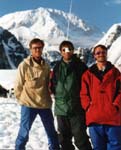 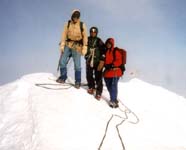
The descend to the upper camp and fall asleep. All these days we
ate very little, something appeared to be wrong with the menu. We
drank rather little too. All the climbers do not part with the bottles
with water. Good for them. Next day we descend to 3300m camp, and
next we go further down. Again those clouds. Finally, we penetrate
them through and find ourselves in the lower part of the Kaheeltna
glacier. This time we manage to have a look at the surroundings.
It doesn't resemble any mountains I know of. Maybe it resembles
the Moon surface. Not a sign of life. The scales are characteristic
for Pamirs, though the mountains look more like Caucasian. Serega
and me take snow baths. Igor and Misha are pessimistic about it.
Contrary to the feeling I had when we descended from Korjeneva (and
then I felt that I had acquired something), now I feel that I have
lost something.
When we approach the base camp 2200m, the girl-ranger comes out
of the rocks and shouts:"What company?". You know what
she meant? What company we took to fly here. She had to know it
to send a radio to the pilot to take us to Talkeetna. We decided
not to go back by feet, since there wasn't snow enough and we would
lose time curling between crevasses.
So, we flew back. It took us ten days for the round trip.
3.
Kilimanjaro
What
could be the next plan? How else could we spent our vacations? Parting
in the Anchorage airport and drinking vodka, we thought that it
would be probably good, when all of us are retired, drift on a raft
across some ocean. Not bad idea. Too long to wait.
The time moved on again. With Serega's help I managed to earn some
money in America to spend it in Russia. In autumn 2001 there appeared
a plan to go to Akoncagua, Argentina, on Christmas 2002. This is
the highest point in South America, by the way. But the hell! Who
has any doubts that we will manage it? Again all those excursions.
Yes, the company is good. Yes, the mountain is high. Yes, it's in
the Southern Hemisphere where I have not been and even am not sure
that it exists. And it is so expensive, and rather little money
left! Doubtful, doubtful. Only in case there is a new grant.
On the June evening I came home from my job, dined in the kitchen,
smoked and read a newspaper. The radio mumbled something. Suddenly
a voice said: "And now our guest Victor Boyarsky will tell
you about his plans". I put the newspaper away. I knew Victor
years ago when we both worked at the "North Pole" drifting
station, and now he was a famous polar traveler. The familiar voice
that had not changed said: "We are going to fulfill a "7+"
plan dedicated to the 300 anniversary of St-Petersburg. That is
to ascend 7 highest mountains of the continents and reach the North
Pole on skies. In 5 days our expedition is ready to fly to Kilimanjaro,
the main thing, that is the yellow fever vaccination, is done. The
details can be obtained by the phone…". My Lord! OK, I am through
with Kilimanjaro, it's a pity, but maybe I can get in touch with
this company in future. McKinley experience could be useful and
I remain in the ranks up to now. I called him next day and we met.
After a talk, I told him all that. "Why! Come now with us to
Kili", he said. "Is it not too late? I have not got this
fever shot and what about the visa?". "Just say you go,
and I'll send you to the hospital and arrange the hotel for you
there. As to the visa, there are 3 days left. Why not go to Moscow
to get it or just learn if you could get it on the border?".
So it happened.
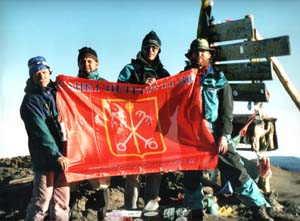
The right impression of Kili one can get from the plane, the direct
flight from Amsterdam to Kilimanjaro airport. It's a solitary mountain
on the plain. A volcano, by the way. Like those one can see at Kamchatka,
but with a crater 5 kilometers wide. The solitary mountain produces
a different impression from all the other mountains. And besides,
which is not the least important, this Kilimanjaro is a cultural
reference of my youth. The snows, the leopard… Like visiting childhood
dreams.
But if you visit it to have some tramping/climbing, you should know
something beforehand. This mountain is a National Park and is the
main hard currency resource for Tanzania, and that's why it is strictly
guarded by the armed rangers and only fixed paths can be used to
walk there. For two days we went up, first through the rainy jungles
(with monkeys), then through alpine meadows full of flowers. No
tents. There are sites with wood houses and sun batteries and dining
huts where you will get the regular (though partly African) food.
From the site 3800m, we made an acclimatization trip and on the
next day moved to the last camp at 4800m. All the way there is a
good road, no snow, it's warm and it's not difficult to breath.
Remember that oxygen that the polar McKinley lost? Here it was now
as an extra portion. We started at midnight. The ascent is no problem,
it is just a talus. Of course, one has to have some health, but
not too much. After a kilometer ascent, we got to the crater ridge
and went to the left to reach the highest point which is 5895m.
At the dawn we were there and met the rising sun at the 3-rd degree
of southern latitude and on the highest point of Africa. The crater
is huge. There is some snow on this side of it, though we have not
touched it, and there is a lot of it on the opposite side. A picturesque
view. No leopard neither here, nor there, nobody of the locals ever
heard of it. News in blues.
In the evening we were back in 3800m camp. Next day we left the
Park. I took a stone from the top. They say one can see it in the
special labyrinth built of stones from all over the world in St-Petersburg
University's back yard.
|
|
|








